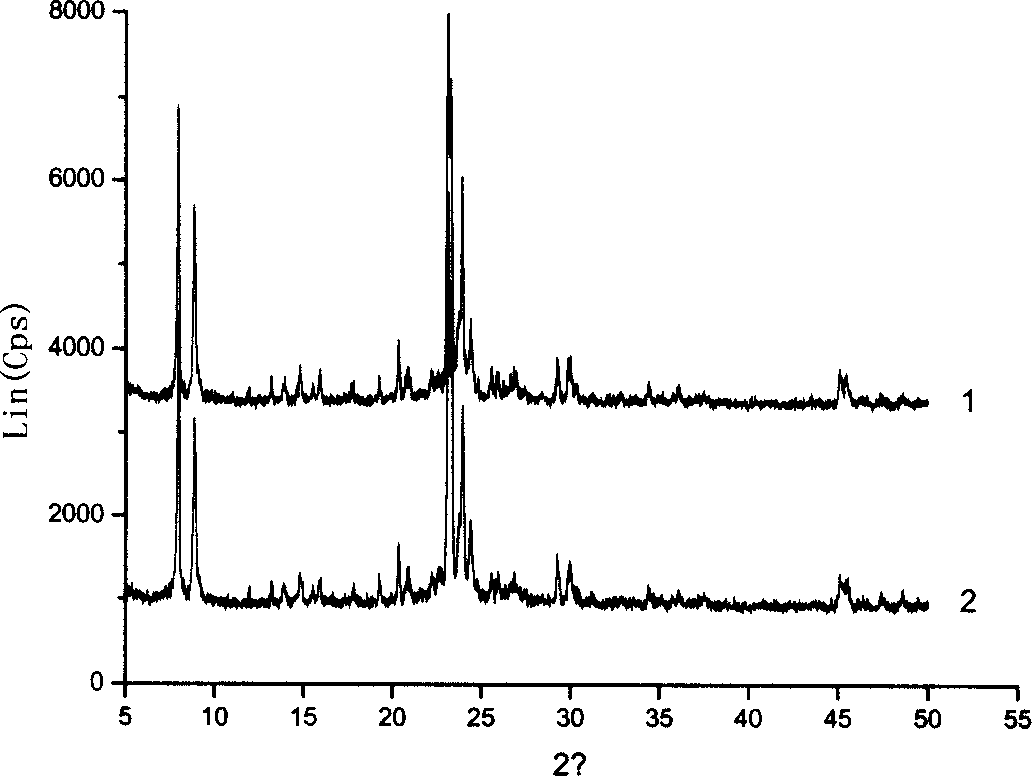Catalyst for preparing ethene and propene by catalysis cracking
An ethylene propylene and catalytic cracking technology, applied in physical/chemical process catalysts, molecular sieve catalysts, hydrocarbon cracking to produce hydrocarbons, etc., can solve the problems of high operating temperature, low catalyst activity, and low ethylene propylene yield.
- Summary
- Abstract
- Description
- Claims
- Application Information
AI Technical Summary
Problems solved by technology
Method used
Image
Examples
Embodiment 1
[0019] Take 284 grams of sodium metasilicate, dissolve it into solution A with 300 grams of distilled water, take 5.56 grams of aluminum sulfate, and make solution B with 100 grams of distilled water, slowly pour B solution into A solution, stir vigorously, and then add 12.2 grams of B Diamine and 29.4 grams of tetraethylammonium hydroxide (the mixed template is denoted as M), after stirring for a period of time, adjust the pH value at 11 with dilute sulfuric acid, and control the molar ratio of the sol: Si: Al: M: H 2 O=1:0.0167:0.4:40, add 2.8 grams of zeolite beta seed crystals, put the mixed solution in an autoclave, keep it at 160°C for 40 hours, then take it out and wash it twice, dry at 120°C for 4 hours, and bake at 550°C 3 hours, made ZSM-5 / beta zeolite intergrowth molecular sieve, XRD diffraction pattern as figure 1 As shown in the middle curve 1, it can be known by XRD diffraction that the weight percentage of ZSM-5 in the intergrown molecular sieve is 94.6%, and th...
Embodiment 2~4
[0021] According to the method of Example 1, the pH of the solution was controlled to be 10.5, 11.5 and 12 respectively, and ZSM-5 / beta zeolite intergrowth molecular sieves were synthesized respectively, which were respectively marked as FH-2, FH-3 and FH-4. The ratio of ZSM-5 and zeolite beta is shown in Table 3. Evaluation according to the method of Example 1, the results are shown in Table 4.
Embodiment 5~11
[0023] According to the method of Example 1, the different molar ratios of the solutions are controlled, and the ratio of the two in the mixed template agent remains unchanged. The ZSM-5 / beta zeolite symbiotic molecular sieves synthesized respectively are shown in Table 2, and the ratios of ZSM-5 and beta zeolite are shown in Table 2. 3. Evaluation according to the method of Example 1, the results are shown in Table 4.
[0024] Table 2
[0025] Example
PUM
| Property | Measurement | Unit |
|---|---|---|
| pore size | aaaaa | aaaaa |
Abstract
Description
Claims
Application Information
 Login to View More
Login to View More - R&D
- Intellectual Property
- Life Sciences
- Materials
- Tech Scout
- Unparalleled Data Quality
- Higher Quality Content
- 60% Fewer Hallucinations
Browse by: Latest US Patents, China's latest patents, Technical Efficacy Thesaurus, Application Domain, Technology Topic, Popular Technical Reports.
© 2025 PatSnap. All rights reserved.Legal|Privacy policy|Modern Slavery Act Transparency Statement|Sitemap|About US| Contact US: help@patsnap.com

